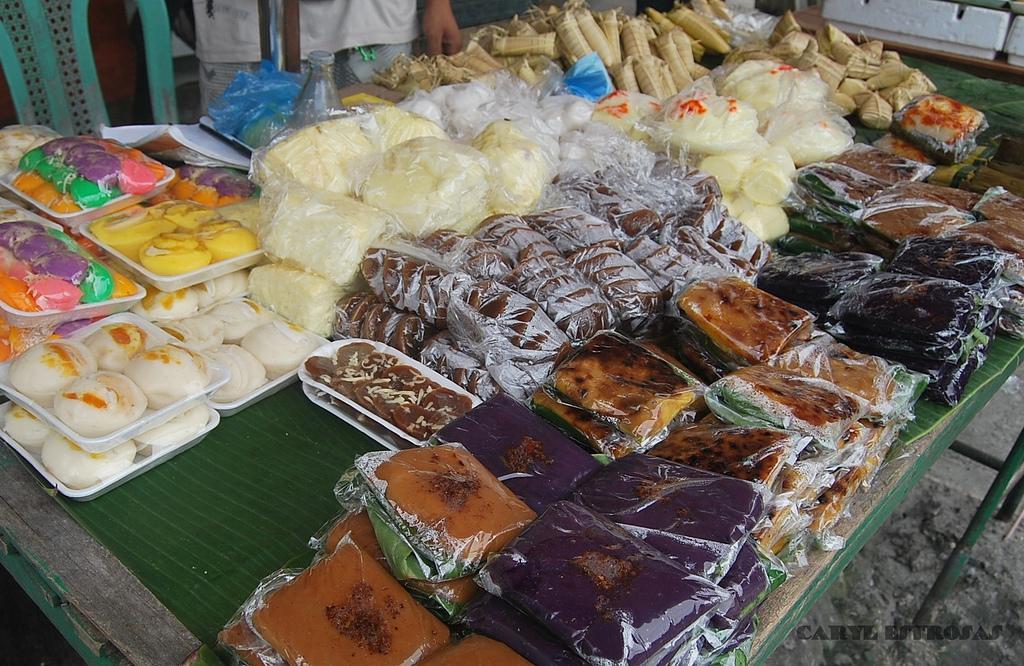
Filipinos love to eat, especially food that are sweet. This is probably why their ancestors came up with a bewildering array of traditional snacks and sweets that truly cater to the tastes of the young and old alike. Being in a pleasantly tropical country, it should come as no surprise that rice, sugar and coconut make up the list of ingredients for the many snacks and sweets that are labeled as distinctly Filipino. Be it for merienda, dessert or pasalubong to loved ones, these traditional food are a delight to have, and, of course, eat.
Below are 10 traditional Filipino snacks and sweets that have been loved and enjoyed by many generations:
1. Bibingka

Although many would think of bibingka as a mostly Philippine Christmas food sold outside of churches during Christmas season, there are also sold in stalls and stores that sell these treats all year round. Best served and eaten hot off the coals, its soft, fluffy consistency and an amazing diversity of flavor from the dough itself and toppings make bibingka probably the most well-known Filipino snack. Bibingka is made with rice flour and coconut milk or water. Other ingredients can vary greatly, but the most common secondary ingredients are eggs and milk. The traditional preparation is very time-consuming. A specially made terra cotta container is lined with a single large section of a banana leaf. It is placed over preheated coals and the rice flour and water mixture is poured into it, taking care not to spill it into the container itself. Another piece of banana leaf is added to the top and covered with more preheated coals. Commercial bibingka in banana leaf liner showing the distinctive notched edges
The end result is a soft and spongy large flat cake that is slightly charred on both surfaces and infused with the unique aroma of toasted banana leaves. Toppings are then added, usually consisting of butter/margarine, sugar, cheese, or grated coconut. Other more uncommon toppings include pinipig (pounded immature rice grains), pineapple, and salted duck eggs. A mixture of two or more of these toppings on a single bibingka is also common. Bibingka with sumptuous amounts of toppings (and ingredients) are sometimes called Bibingka Especial.
2. Kalamay

Kalamay, also spelled Calamay, is another Filipino delicacy that is popular all over the islands, and each province, town or locality have their own special versions in their manner of preparation and unique local ingredients. It is usually made of coconut milk, brown sugar, and ground glutinous rice. They can also be flavored with margarine, peanut butter, or vanilla. Kalamay can be eaten alone but is usually used as a sweetener for a number of Filipino desserts and beverages.
Kalamay is made by extracting coconut milk from grated coconuts twice. Glutinous rice is added to the first batch of coconut milk and the mixture is ground into a paste. Brown sugar is added to the second batch of coconut milk and boiled for several hours to make latík. The mixture of ground glutinous rice and coconut milk is then poured into the latík and stirred until the consistency becomes very thick. It can be served hot or at room temperature especially when eaten with other dishes. Viscous kalamay are often served cooled to make it less runny and easier to eat. Kalamay is a popular pasalubong (the Filipino tradition of a homecoming gift).
3. Suman

Suman is a rice cake originating in the Philippines. It is made from glutinous rice cooked in coconut milk, and often steamed in banana leaves. It is served wrapped in buli or buri palm leaves and usually eaten sprinkled with sugar. Suman is also known as budbod in the Visayan languages which dominate the southern half of the country
Suman wrapping is a unique art in itself, and can be traced to pre-colonial roots which have had contact with Indian traditions. Wrappers utilize a wide variety of indigenous materials such as palm, banana, anahaw and bamboo leaves, coconut shells, and others. Some wrappings are simple folds such as those found in the binuo and the kamoteng kahoy, resulting in rectangular suman. Others are in vertical coils like the inantala, giving it a tubular form. Still others are in pyramid-like shapes, like the balisungsong. Some forms of suman are eaten like ice cream–with cones made from banana leaves, and still others are in very complex geometric patterns like the pusu ("heart"). Some are woven into the shape of a banana blossom (which in the Philippines is referred to as the banana plant's "heart"), or the pinagi (from the word pagi, meaning stingray), a complex octahedral star.
4. Puto

Puto is a kind of steamed rice cake in Philippine cuisine. It is eaten as is or with butter and/or grated fresh coconut or as accompaniment to a number of savory dishes for breakfast, most notably, with dinuguan.
Properly prepared puto is soft, moist, has fine uniform grain and imparts the slightly yeasty aroma of fermented rice batter overladen with a light whiff of anise seeds. It should be neither sticky nor dry and crumbly. The essential flavor should be of freshly cooked rice, sweetened a bit more if being eaten as stand-alone snack instead of as accompaniment to certain savory dishes. Since most puto as cooked in the Tagalog speaking regions of the Philippines may contain a tiny quantity of wood ash lye and from time to time may be steamed and served on sheets of banana fronds, it is not rare at all for puto aficionados to seek also the subtle flavors of these two last elements in well-made traditional puto.
In the last few decades, a lot of experimentation has been carried out by both home cooks and producers to improve puto’s already general appeal by introducing ever new variations in shape, texture, flavoring and color. It could very well be that deficiencies in the essential flavor and texture of unsatisfactorily made puto resulting from short-cuts and decline in the quality of ingredients used that might have prompted them into trying out new and alien flavors and flavorings such as vanilla or to the tarting up of its immaculate whiteness with garish coloring to mask and compensate for qualities that are sorely missed in imperfectly made puto.
5. Sapin-sapin

Although most commonly seen in feasts and gatherings, sapin-sapin can be sold by street vendors or stall in marketplaces. What makes sapin-sapin an enticing treat is its layers of different colors placed on top of each other, hence the origin of its name. Sapin-sapin is a layered glutinous rice and coconut dessert in Philippine cuisine. It is made from rice flour, coconut milk, sugar, water, and coloring with coconut flakes sprinkled on top. Sapin-sapin means "layers" and the dessert is recognizable for its layers, each colored separately. It has been referred to as "a blancmange of several colored layers, sweetened and flavored with coconut milk."
6. Palitaw

Palitaw is a sweet, sticky treat that is often served for meriends. Its name is derived from the word "litaw," the Tagalog word for "float" or "rise." The palitaw is a small, flat, sweet rice cake eaten in the Philippines. They are made from malagkit (sticky rice) washed, soaked, and then ground. After excess water is let out from the grinding process scoops of the batter are rolled and the flattened to disk shapes and dropped into boiling water where they float to the surface as flat discs - an indication that they're done. When served, the flat discs are dipped in grated coconut, and presented with a separate dip made of sugar and toasted sesame seeds.
7. Ube Halaya

Ube halaya requires a considerable amount of preparation, which is why this is viewed as a rare treat and is normally only seen cooked fresh during town fiestas, Christmas, or other special occasions. Ube is purple yam, and in many provinces in the Philippines, this root crop is harvested and prepared explicitly for this delicacy. To prepare the yams, they must be first cleaned, boiled, peeled, shredded or grated. The yam is then placed in llaneras or small oval aluminum pans and is heated. Milk and sugar are then introduced later. This then makes a treat that is flavorful and creamy, usually served with margarine of butter on top.
8. Ginataan

Although ginataan can be found all year round, this traditional Filipino treat can be one of the best things you'll ever have when served hot on a particularly cold and/or rainy day. This treat is made from gata, or coconut milk, from which it derives its name. The cocout milk serves as the base for this sweet stew with a variety of ingredients that can include saba or plantains, tapioca, kamote or sweet potato, cassava, ube or yam, and langka or jackfruit. This makes for a thick soup-like snack that when served hot makes for a sweet, filling and satisfying meal.
9. Kutsinta

A favorite of Filipinos for breakfast or merienda, the kutsinta or cuchinta is a brown or orange rice cake that is sold in many locations and is enjoyed in many places in the Philippines. It can be served as homemade or there were those who sell them in the streets or nilalako. It is often served with grated coconut meat. Filipinos enjoy it as a quick filling snack or along with other sweets.
10. Puto Bumbong

Along with bibingka, Puto Bumbong is often served outside churches around Christmas time. Puto Bumbong is a type of puto or rice cake named after the bamboo tube in which it is steamed. It is unusual among puto, being sticky and having a long thin shape and purple color. The elongated shape results from the method of cooking while its color comes from the violet pirurutong rice it is made of. It is served with grated coconut and brown sugar.










